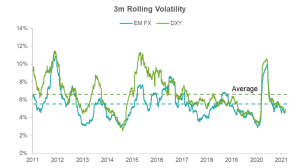Resumo do Relatório
FX Dashboard: EM FX Volatility Remains Low
With US Treasury markets on a tear, the dollar index (DXY) strengthened 0.4%, going back to 90.5 after dropping below 90 over the last couple of days. The dollar strengthening pushed EM currencies weaker by 0.2% on average, with the Indian rupee (INR), the Indonesian rupiah (IDR), and the Turkish lira (TRY) depreciating 1.4%, 1.1%, and 1.0%, respectively.
While the sharp rise in US yields is causing turbulence in global equity markets, EM currencies have been on the sideline of the onslaught. There have been pockets of volatility in some high-beta currencies such as the Mexican peso (MXN), the Brazilian real (BRL), and TRY. For the most part, though, EM currencies have been quite resilient as they have weakened on average by only 0.2% in spot terms over the past month. More importantly, their 3m volatility has remained stable and below their long-term average over the past couple of months (see chart below).
In terms of the reasons behind the stability in EM currencies:
- We have made the point in previous notes that currently dollar is the main driver for EM currencies on aggregate with their correlation close to the high end of their historical range (see, for example, FX Dashboard: Dollar in the Driver’s Seat). The dollar itself has traded in a narrow range since mid-December, with DXY staying within 89.5-91.5 and its volatility is far lower than the historical average (see chart below). We expect the dollar to stay within this range for the time being. Last year, the dollar was weakening mainly due to expectations of weak growth in the US. With the Democrats taking control of the US Senate earlier this year, the scenario changed as they are moving ahead with a large fiscal stimulus which has taken away the scenario of US growth underperforming.
- EM currencies on aggregate recovered from their worst levels at the start of the pandemic but have still not reached their pre-pandemic levels. Moreover, in real effective exchange rate terms, they remain cheap (see here). Also, currencies in countries with weak fundamentals, particularly Brazil and Turkey, did not participate in the rally. Finally, EM currencies have lagged other risky assets this year (see here). As such, EM currencies were nowhere close to frothy levels.
The current stability of EM currencies, however, does not preclude a rise in volatility going forward. Currently, the reflationary scenario has only gone so far as to stop the dollar from depreciating. However, if it becomes clear that US growth will significantly outperform other developed countries, the dollar can start appreciating. Another plausible scenario where the dollar can appreciate is if risk aversion takes over for example following a deep correction in US equities. Either scenario of dollar appreciation can act as a headwind for EM currencies. Barring these scenarios playing out, the volatility of EM currencies can continue to stay low.

Data Source: Refinitiv; Note EM refers to equally weighted spot returns for 22 liquid EM currencies
Best Longs / Best Shorts
- Our list of underperformers in the attached FX Dashboard pdf stayed unchanged with the Philippine peso (PHP) on it.
- From the list of outperformers, we removed TRY following its underperformance today, leaving only the Taiwan dollar (TWD).
Best Crosses
- Our list of preferred relative-value trades stayed unchanged with Long MXN vs Short the Australian dollar (AUD) or TRY or the British pound (GBP) or the Canadian dollar (CAD).
- As we mentioned yesterday, of these pairs, we recommended Long MXN vs Short CAD in a recent trade note.
- The 3m expected returns for these pairs come off the highs and are now in the range of 8-11% (not annualized), assuming mean reversion.
Aviso legal
DISCLAIMER: Este Relatório de Análise foi elaborado e distribuído pelo Analista, signatário unicamente para uso do destinatário original, de acordo com todas as exigências previstas na Resolução CVM nº 20 de 26 de fevereiro de 2021 e tem como objetivo fornecer informações que possam auxiliar o investidor a tomar sua própria decisão de investimento, não constituindo qualquer tipo de oferta ou solicitação de compra e/ou venda de qualquer produto. As decisões de investimentos e estratégias financeiras devem ser realizadas pelo próprio leitor, os Analistas, ou a OHMRESEARCH não se responsabilizam por elas. Os produtos apresentados neste relatório podem não ser adequados para todos os tipos de investidores. Antes de qualquer decisão de investimentos, os investidores deverão realizar o processo de suitability no agente de distribuição de sua confiança e confirmar se os produtos apresentados são indicados para o seu perfil de investidor. A rentabilidade de produtos financeiros pode apresentar variações e seu preço ou valor pode aumentar ou diminuir num curto espaço de tempo. Os desempenhos anteriores não são necessariamente indicativos de resultados futuros. A rentabilidade divulgada não é líquida de impostos. As informações presentes neste material são baseadas em simulações e os resultados reais poderão ser significativamente diferentes.
O(s) signatário(s) deste relatório declara(m) que as recomendações refletem única e exclusivamente suas análises e opiniões pessoais, que foram produzidas de forma totalmente independente e que a OHMRESEARCH não tem qualquer gerência sobre este conteúdo. As opiniões aqui expressas estão sujeitas a modificações sem aviso prévio em decorrência de alterações nas condições de mercado. O Analista responsável pelo conteúdo deste relatório e pelo cumprimento da Resolução CVM nº 20/21 está indicado acima, sendo que, caso constem a indicação de mais um analista no relatório, o responsável será o primeiro analista credenciado a ser mencionado no relatório. Os analistas cadastrados na OHMRESEARCH estão obrigados ao cumprimento de todas as regras previstas no Código de Conduta da APIMEC para o Analista de Valores Mobiliários e no Manual de Controles Internos para Elaboração e Publicação de Relatórios da OHMRESEARCH. De acordo com o art. 21 da Resolução CVM nº 20/21 caso o Analista esteja em situação que possa afetar a imparcialidade do relatório ou que configure ou possa configurar conflito de interesse, este fato deverá estar explicitado no campo “Conflitos de Interesse” deste relatório.
O conteúdo deste relatório é de propriedade única do Analista signatário e não pode ser copiado, reproduzido ou distribuído, no todo ou em parte, a terceiros, sem prévia e expressa autorização deste Analista. Todas as informações utilizadas neste documento foram redigidas com base em informações públicas, de fontes consideradas fidedignas. Embora tenham sido tomadas todas as medidas razoáveis para assegurar que as informações aqui contidas não são incertas ou equívocas no momento de sua publicação, o Analista não responde pela veracidade das informações do conteúdo.
Para maiores informações, pode-se ler a Resolução CVM nº 20/21 e o Código de Conduta da APIMEC para o Analista de Valores Mobiliários. Este relatório é destinado exclusivamente ao assinante da OHMRESEARCH que o contratou. A sua reprodução ou distribuição não autorizada, sob qualquer forma, no todo ou em parte, implicará em sanções cíveis e criminais cabíveis, incluindo a obrigação de reparação de todas as perdas e danos causados, nos termos da Lei nº 9.610/98 e de outras aplicáveis.





